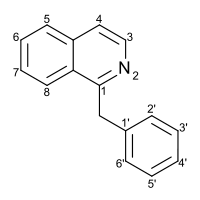Benzylisoquinoline
 | |
| Names | |
|---|---|
| IUPAC name
1-(Phenylmethyl)isoquinoline | |
| Identifiers | |
| 6907-59-1 | |
| ChemSpider | 21830 |
| Jmol interactive 3D | Image |
| PubChem | 23345 |
| |
| |
| Properties | |
| C16H13N | |
| Molar mass | 219.28112 g/mol |
| Except where otherwise noted, data are given for materials in their standard state (at 25 °C [77 °F], 100 kPa). | |
| | |
| Infobox references | |
1-Benzylisoquinoline is a chemical compound, and the structural backbone of many alkaloids with a wide variety of structures, including papaverine, noscapine, codeine, morphine, apomorphine, berberine, protopine, tubocurarine, and sanguinarine.
Biosynthesis
Plants producing benzylisoquinoline alkaloids have a common biosynthetic pathway, making use of two units of L-tyrosine. One tyrosine molecule is metabolised to dopamine which constitutes the isoquinoline part, while the benzylic part is mostly formed from tyramine, itself the decarboxylation product of tyrosine.
Many benzylisoquinolines have a methylated nitrogen atom as well as functional groups containing oxygen (-OH, -OCH3, -OCH2O-) in positions 6, 7, 3' and 4'. The latter come from the precursors mentioned above, namely tyrosine, dopamine and their derivatives.
Examples of benzylisoquinoline alkaloids
-

Apomorphine (one additional ring closure)
-

Morphine (two additional ring closures)
-

Berberine (one additional ring closure with incorporated N-methyl)
-

Protopine (with opened pyridine ring)
-

Tubocurarine (composed of two benzylisoquinoline units)

